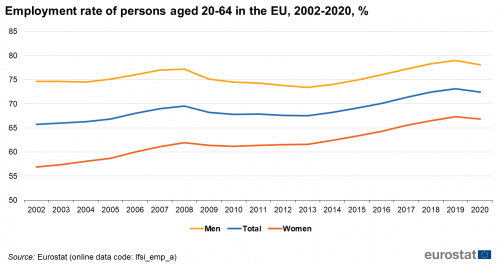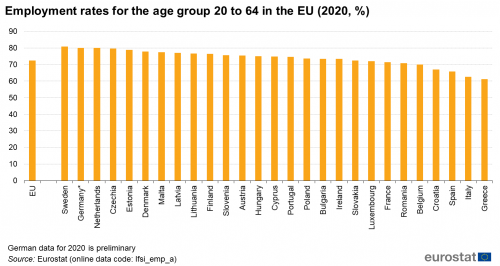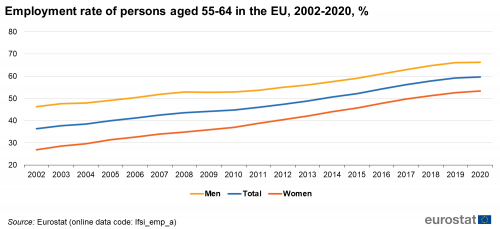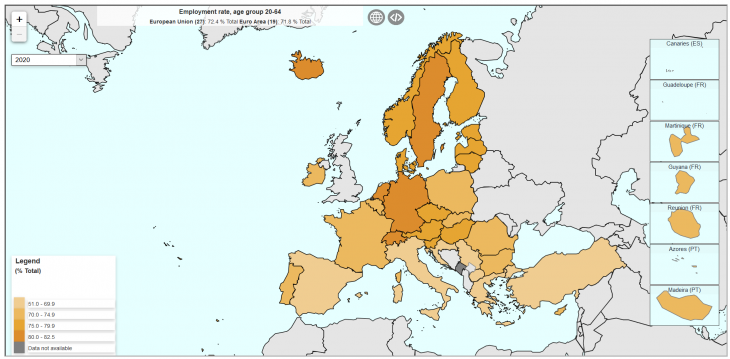Archive:Employment rates – annual statistics
Data from April 2021.
Planned update of the article: May 2022.
Highlights
In 2020, the employment rate in the EU stood at 72.9 % for persons aged 20-64. It has dropped for the first time since 2013 due to the impact of COVID-19 measures on the labour market.
The gender employment gap has decreased from 11.7 to 11.3 percentage points between 2019 and 2020, despite the large impact Covid-19 measures had on women specifically.
This article provides insight in the progression towards higher employment in the EU and the Member States. In 2020 the EU employment rate for persons aged 20-64 stood at 72.9 %, a decrease in comparison with 2019, when the rate was 73.1 %. Throughout the year 2020, Covid-19 measures had an unprecedented and direct impact on the labour market. A decrease in the employment rate was consequently observed in all but three of the EU Member States. The gender employment gap has nevertheless continued its significant decrease, and stood at 11.3 pp in comparison to 11.7 pp in 2019. Persons aged 55-64 have overall been less affected by the measures, and experienced an increase in the employment rate from 59.2 % in 2019 to 59.6 % in 2020.
The employment rate gives information on the share of the population of a certain age group who have a paid job (in other words, of the employed persons). They can be paid in cash or in kind and the person can have a job as an employee, as a self-employed person or as a family worker. In most cases, a paid job is an important indicator of the living standard of people and the employment rate mainly determines the socio-economic conditions of individuals in a country. Moreover, it provides key macroeconomic information as it describes to what extent human resources of a country are mobilized for economic purposes.
Full article
<sesection>
Persistent increase of the employment rate at EU level has halted
In 2020, the employment rate of persons aged 20-64 in the EU dropped by 0.7 pp from 73.1 % in 2019 to 72.4 % . This was the highest drop in the rate recorded since the drop by -1.3 pp between 2008 and 2009, following the debt crisis. The rate in 2020 remained however far above the rate recorded in 2009, when it stood at 68.2 % (Figure 1). Until 2019, the EU had shown robust increases in the employment rate each year after the low of 67.5 % recorded in the wake of the financial crisis in 2013.

<sesection>
EU Member States compared: age group 20-64
As shown in Figure 2, there are notable differences in employment rate across EU Member States. In 2020, there was a difference of 19.7 p.p. between the country with the highest and the country with the lowest employment rate; Sweden recorded the highest rate of 80.8 % while Greece showed the lowest rate at 61.1 %. Between these two extremes, four major groups of countries can be distinguished: one with employment rates lower than 69.9 %, one with rates ranging from 70.0 to 74.9 %, one with rates within the range of 75.0 to 79.9 % and one with rates of 80.0 % or above. Italy, Croatia and Spain are part of the first group, while the second group consists of Belgium, Romania, France, Luxembourg, Slovakia, Ireland, Bulgaria, Poland, Portugal and Cyprus. It is now equally large as the third group, while in 2019, the third group still included more Member States. The third group contains Hungary, Austria, Slovenia, Finland, Lithuania, Latvia, Malta Denmark, Estonia and Czechia. The last group, with the highest employment rates, contains the remaining EU Member State, i.e. the Netherlands. German data in 2020 are not comparable to previous years, and due to be revised, so Germany is not mentioned in any of the groups.

<sesection>
Gender employment gap shrinking, but still sizeable
The gender gap in employment for 2020 is shown in Map 2. The employment gender gap is calculated by subtracting the employment rate for women from that of men.
For the EU overall, the gender employment gap has further diminished in 2020 compared with 2019: from 11.7 p.p. to 11.4 p.p. This decrease at EU-level is the result of a lower drop of women's employment rate between 2019 and 2020 in comparison to that of men. This shows a continuation of the trends observed during the last decade, when the employment rate for men has practically stabilized, and is hit harder during crisis, while that of women continues to grow and is less prone to decrease during times of crisis.

In 2020 compared with 2019, 13 Member States show a decrease in the gender employment gap, while 13 show an increase; no comparison is possible for Germany due to a break in the time series. The highest decrease in the gender employment gap were observed in Malta (-3.0 pp), which nevertheless remains at a high level of 17.7 pp. Further large decreases were registered in Luxembourg (- 2.0 pp, to 7.1pp) as well as Estonia (-1.7 pp, to 6.0 pp) and Portugal (-1.3 pp, to 5.9 pp). The highest gaps in 2020, which in addition increased in comparison to 2019, were estimated for Italy (+0.3 pp, to 19.9 pp) and Romania (+0.3, to 19.3 pp).
<sesection>
More persons aged 55-64 in employment
The European Union has, in addition to the goal to increase the employment rate among women, the policy target to increase the employment rate of the population aged 55-64.
Figure 3 shows the steady increase in the employment rate observed for the overall population as well as separately for men and women aged 55-64. While starting from a low level of 26.9 % for women and 45.2 % for men in 2002, the employment rate has continuously increased each year (with the exception of a single decrease by 0.1 pp for men between 2008 and 2009). Both, the debt and financial crisis as well as the Covid-19 measures throughout 2020 have led to slower growth, but have not changed that trend.

<sesection>
EU Member States compared: age group 55-64
As shown in Figure 4, the differences in employment rate for the age group 55-64 across EU Member States are even higher than those observed for the age group 20-64. In 2020, there was a difference of 33.4 p.p. between the country with the highest and the country with the lowest employment rate; Sweden shows the highest rate with 77.6 % while Luxembourg has the lowest rate of 44.0 %. Overall, in 9 countries more than two thirds of the population aged 55-64 still work, while in 4 countries, less than half of the population of that age group works.

<sesection>
Data sources
Source: The European Union Labour Force Survey (EU-LFS) is the largest European household sample survey providing quarterly and annual results on labour participation of people aged 15 and over as well as on persons outside the labour force. It covers residents in private households. Conscripts in military or community service are not included in the results.
Reference period: Yearly results are obtained as averages of the four quarters in the year.
Coverage: The results from the survey currently cover all European Union Member States, the United Kingdom, the EFTA Member States of Iceland, Norway, Switzerland, as well as the candidate countries Montenegro, North Macedonia, Serbia and Turkey. For Cyprus, the survey covers only the areas of Cyprus controlled by the Government of the Republic of Cyprus.
European aggregates: EU refers to the sum of EU-27 Member States. If data are unavailable for a country, the calculation of the corresponding aggregates takes into account the data for the same country for the most recent period available. Such cases are indicated.
Definitions: The concepts and definitions used in the survey follow the guidelines of the International Labour Organisation. Employment covers persons aged 15 years and over (16 and over in Spain and Italy, 15-74 years in Estonia, Latvia, Hungary, Finland, Sweden, Norway and Denmark, and 16-74 years in Iceland), living in private households, who during the reference week performed work, even for just one hour, for pay, profit or family gain, or were not at work but had a job or business from which they were temporarily absent, for example because of illness, holidays, industrial dispute or education and training.
The LFS employment concept differs from national accounts domestic employment, as the latter sets no limit on age or type of household, and also includes the non-resident population contributing to GDP and conscripts in military or community service.
The EU-LFS is based on the same target populations and uses the same definitions in all countries, which means that the results are comparable between the countries.
Five different articles on detailed technical and methodological information is linked from the overview page EU labour force survey.
Please note that Eurostat provides two sets of indicators linked to the annual employment rate, which serve different purposes and which in some cases differ from each other:
1) The main indicators, which also contains quarterly seasonally adjusted series. They include the labour market headline indicators used e.g. in MIPS or the Recovery Dashboard and are consequently used for monitoring policy. They have only a few breakdowns and normally refer to the age group 20-64. Please note that for France, two series are published: one including overseas departments starting in 2003, and one for metropolitan France, excluding overseas departments, starting in 1992. The latter is included in the relevant EU and EA aggregates.
2) The detailed results, which also contain quarterly series that are not seasonally adjusted. They have a large number of breakdowns and can therefore be used for more detailed analysis. For France, only one data series is published. This series contains data for metropolitan France until the fourth quarter of 2013, and from 2014 on, also the French overseas departments.
This article presents annual results for some indicators from the "main indicators" set.
Context
Employment statistics are at the heart of many EU policies. The European employment strategy (EES) was launched at the Luxembourg jobs summit in November 1997 and was revamped in 2005 to align the EU’s employment strategy more closely to a set of revised Lisbon objectives, and in July 2008, employment policy guidelines for the period 2008–2010 were updated. More recently, the European Pillar of Social Rights has been jointly signed by the European Parliament, the Council and the Commission on 17 November 2017. Employment and social policies are the main fields of interest of the European Pillar of Social Rights, which is about delivering new and more effective rights for citizens. It has 3 main categories: (1) Equal opportunities and access to the labour market, (2) Fair working conditions and (3) Social protection and inclusion. In particular, today's more flexible working arrangements provide new job opportunities especially for the young but can potentially give rise to new precariousness and inequalities. Building a fairer Europe and strengthening its social dimension is a key priority for the Commission. The European Pillar of Social Rights is accompanied by a ‘social scoreboard’ which monitors the implementation of the Pillar by tracking trends and performances across EU countries in 12 areas and feeds into the European Semester of economic policy coordination. The scoreboard also serves to assess progress towards a social ‘triple A’ for the EU as a whole.
The EU-LFS is an important source of information about the situation and trends in the national and EU labour markets. Each quarter around 1.8 million interviews are conducted throughout the participating countries to obtain statistical information for some 100 variables. Due to the diversity of information and the large sample size, the EU-LFS is also an important source for other European statistics like Education statistics or Regional statistics.
Direct access to
